Global Union Federations: A Critical Review
VerifiedAdded on 2023/06/08
|8
|1494
|341
AI Summary
This report analyzes the different constraints and opportunities of Global Union Federations (GUFs) in managing industrial relations. It discusses the key concepts, propositions, and methods of data collection and analysis used in the literature review. The report also provides research findings, contribution of the research study, and recommendations for improving GUFs.
Contribute Materials
Your contribution can guide someone’s learning journey. Share your
documents today.
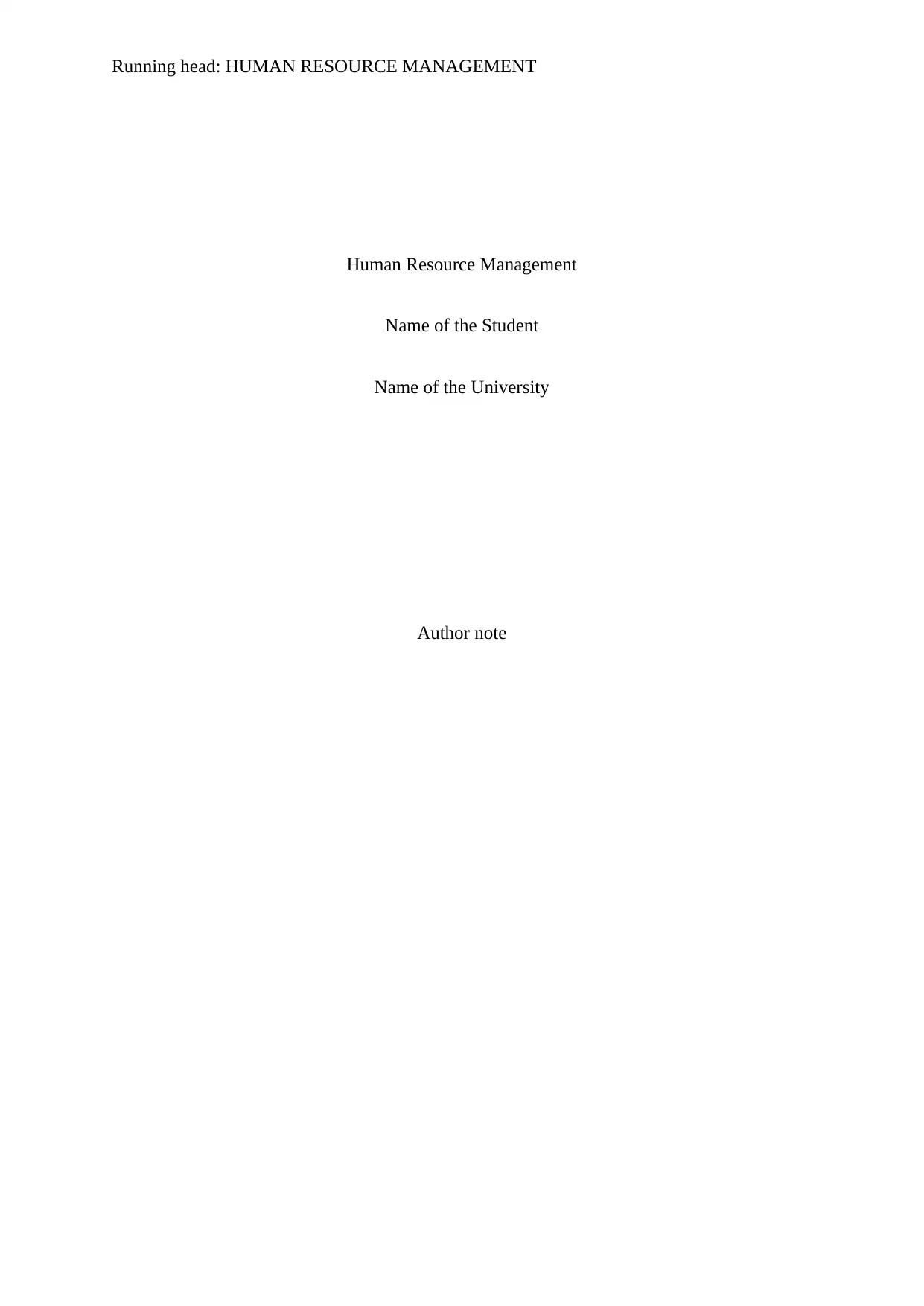
Running head: HUMAN RESOURCE MANAGEMENT
Human Resource Management
Name of the Student
Name of the University
Author note
Human Resource Management
Name of the Student
Name of the University
Author note
Secure Best Marks with AI Grader
Need help grading? Try our AI Grader for instant feedback on your assignments.
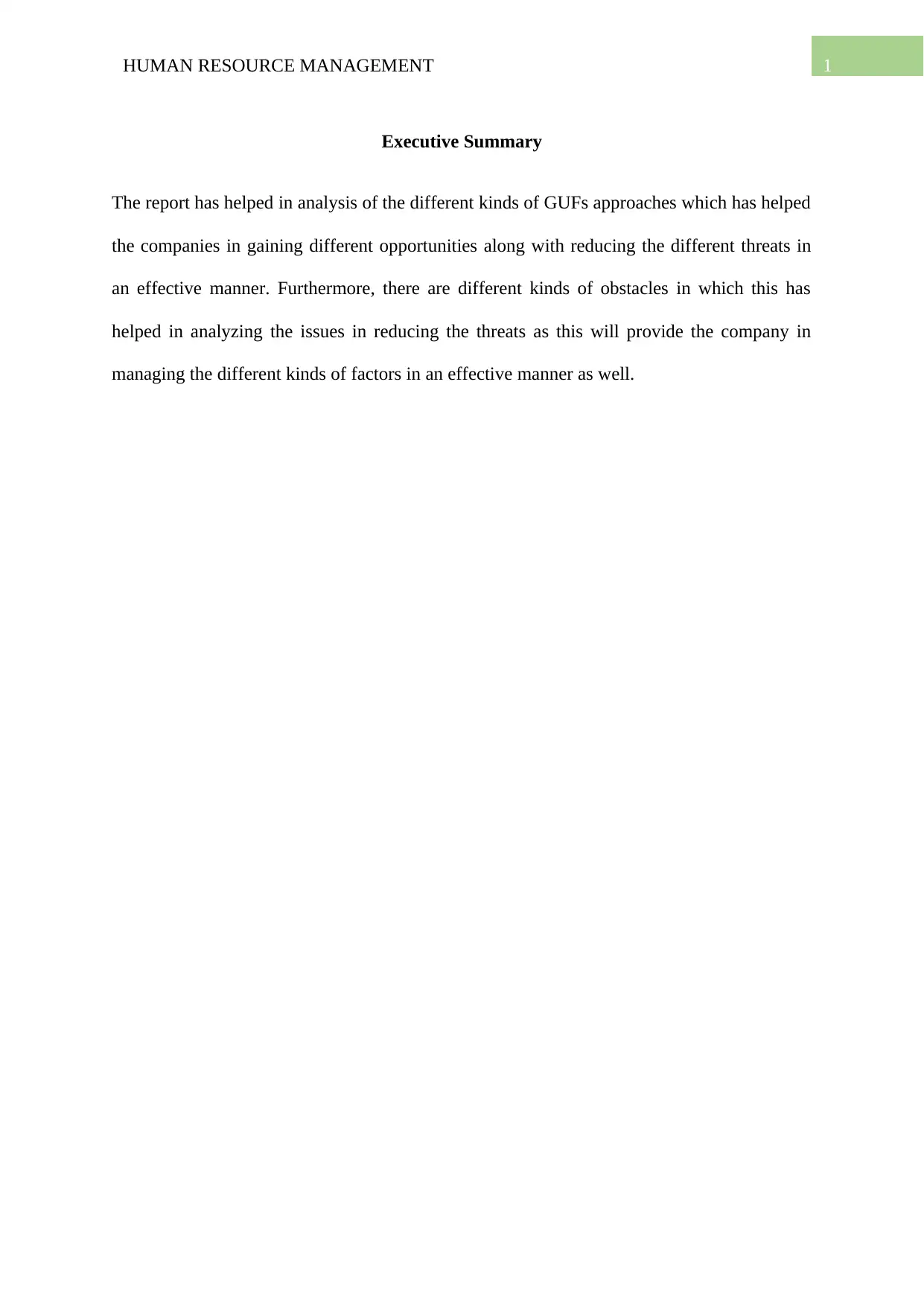
1HUMAN RESOURCE MANAGEMENT
Executive Summary
The report has helped in analysis of the different kinds of GUFs approaches which has helped
the companies in gaining different opportunities along with reducing the different threats in
an effective manner. Furthermore, there are different kinds of obstacles in which this has
helped in analyzing the issues in reducing the threats as this will provide the company in
managing the different kinds of factors in an effective manner as well.
Executive Summary
The report has helped in analysis of the different kinds of GUFs approaches which has helped
the companies in gaining different opportunities along with reducing the different threats in
an effective manner. Furthermore, there are different kinds of obstacles in which this has
helped in analyzing the issues in reducing the threats as this will provide the company in
managing the different kinds of factors in an effective manner as well.
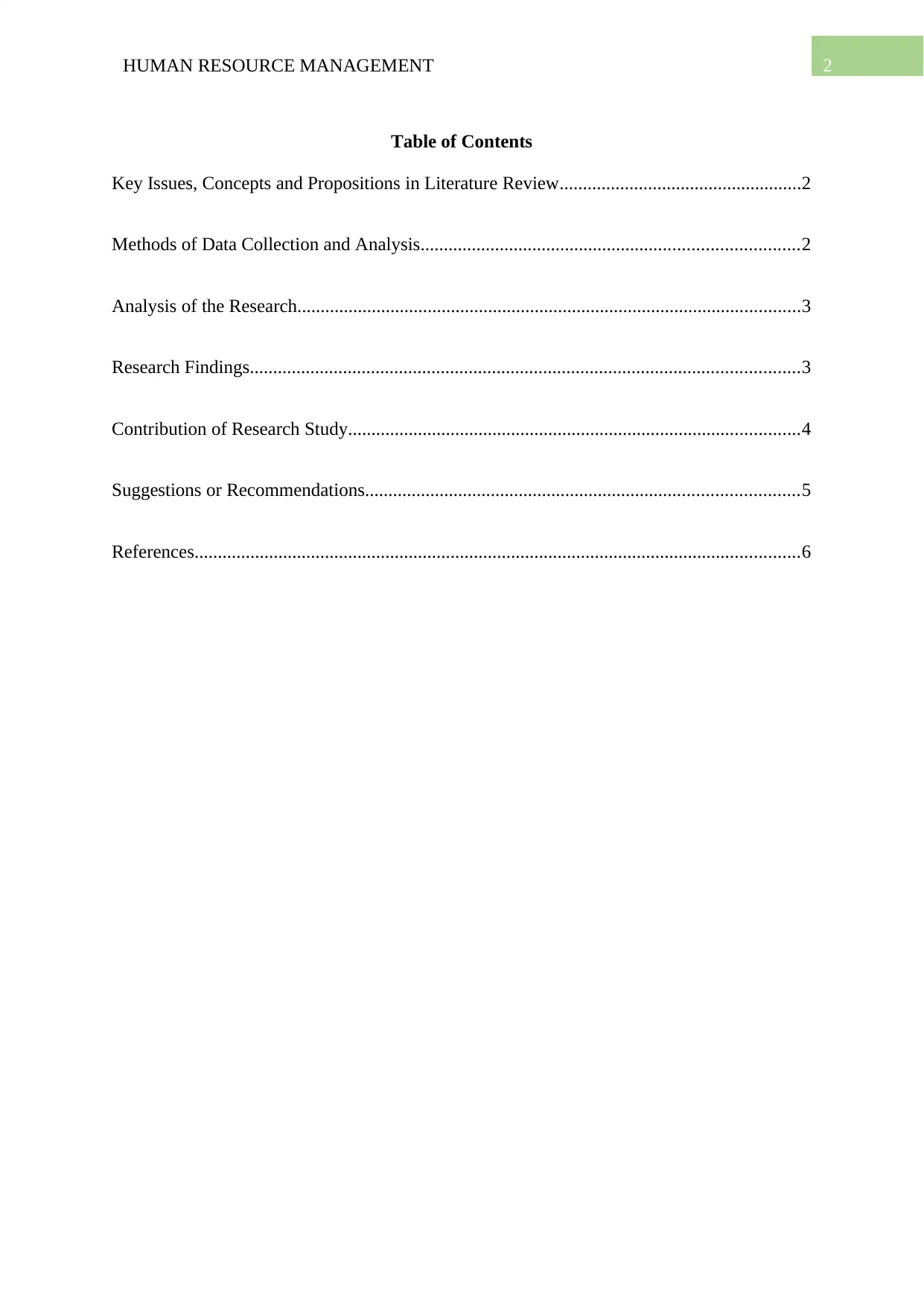
2HUMAN RESOURCE MANAGEMENT
Table of Contents
Key Issues, Concepts and Propositions in Literature Review....................................................2
Methods of Data Collection and Analysis.................................................................................2
Analysis of the Research............................................................................................................3
Research Findings......................................................................................................................3
Contribution of Research Study.................................................................................................4
Suggestions or Recommendations.............................................................................................5
References..................................................................................................................................6
Table of Contents
Key Issues, Concepts and Propositions in Literature Review....................................................2
Methods of Data Collection and Analysis.................................................................................2
Analysis of the Research............................................................................................................3
Research Findings......................................................................................................................3
Contribution of Research Study.................................................................................................4
Suggestions or Recommendations.............................................................................................5
References..................................................................................................................................6
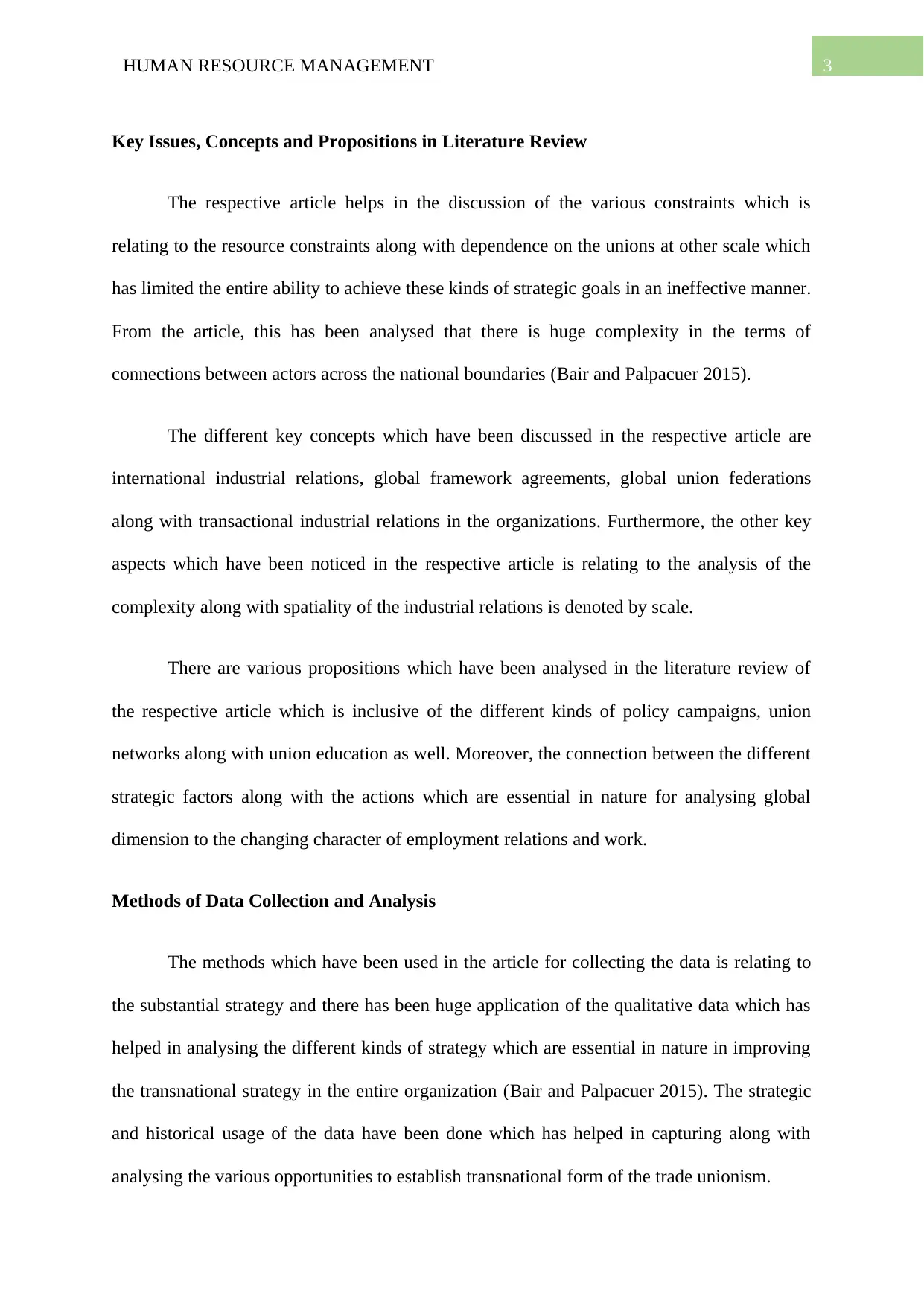
3HUMAN RESOURCE MANAGEMENT
Key Issues, Concepts and Propositions in Literature Review
The respective article helps in the discussion of the various constraints which is
relating to the resource constraints along with dependence on the unions at other scale which
has limited the entire ability to achieve these kinds of strategic goals in an ineffective manner.
From the article, this has been analysed that there is huge complexity in the terms of
connections between actors across the national boundaries (Bair and Palpacuer 2015).
The different key concepts which have been discussed in the respective article are
international industrial relations, global framework agreements, global union federations
along with transactional industrial relations in the organizations. Furthermore, the other key
aspects which have been noticed in the respective article is relating to the analysis of the
complexity along with spatiality of the industrial relations is denoted by scale.
There are various propositions which have been analysed in the literature review of
the respective article which is inclusive of the different kinds of policy campaigns, union
networks along with union education as well. Moreover, the connection between the different
strategic factors along with the actions which are essential in nature for analysing global
dimension to the changing character of employment relations and work.
Methods of Data Collection and Analysis
The methods which have been used in the article for collecting the data is relating to
the substantial strategy and there has been huge application of the qualitative data which has
helped in analysing the different kinds of strategy which are essential in nature in improving
the transnational strategy in the entire organization (Bair and Palpacuer 2015). The strategic
and historical usage of the data have been done which has helped in capturing along with
analysing the various opportunities to establish transnational form of the trade unionism.
Key Issues, Concepts and Propositions in Literature Review
The respective article helps in the discussion of the various constraints which is
relating to the resource constraints along with dependence on the unions at other scale which
has limited the entire ability to achieve these kinds of strategic goals in an ineffective manner.
From the article, this has been analysed that there is huge complexity in the terms of
connections between actors across the national boundaries (Bair and Palpacuer 2015).
The different key concepts which have been discussed in the respective article are
international industrial relations, global framework agreements, global union federations
along with transactional industrial relations in the organizations. Furthermore, the other key
aspects which have been noticed in the respective article is relating to the analysis of the
complexity along with spatiality of the industrial relations is denoted by scale.
There are various propositions which have been analysed in the literature review of
the respective article which is inclusive of the different kinds of policy campaigns, union
networks along with union education as well. Moreover, the connection between the different
strategic factors along with the actions which are essential in nature for analysing global
dimension to the changing character of employment relations and work.
Methods of Data Collection and Analysis
The methods which have been used in the article for collecting the data is relating to
the substantial strategy and there has been huge application of the qualitative data which has
helped in analysing the different kinds of strategy which are essential in nature in improving
the transnational strategy in the entire organization (Bair and Palpacuer 2015). The strategic
and historical usage of the data have been done which has helped in capturing along with
analysing the various opportunities to establish transnational form of the trade unionism.
Secure Best Marks with AI Grader
Need help grading? Try our AI Grader for instant feedback on your assignments.
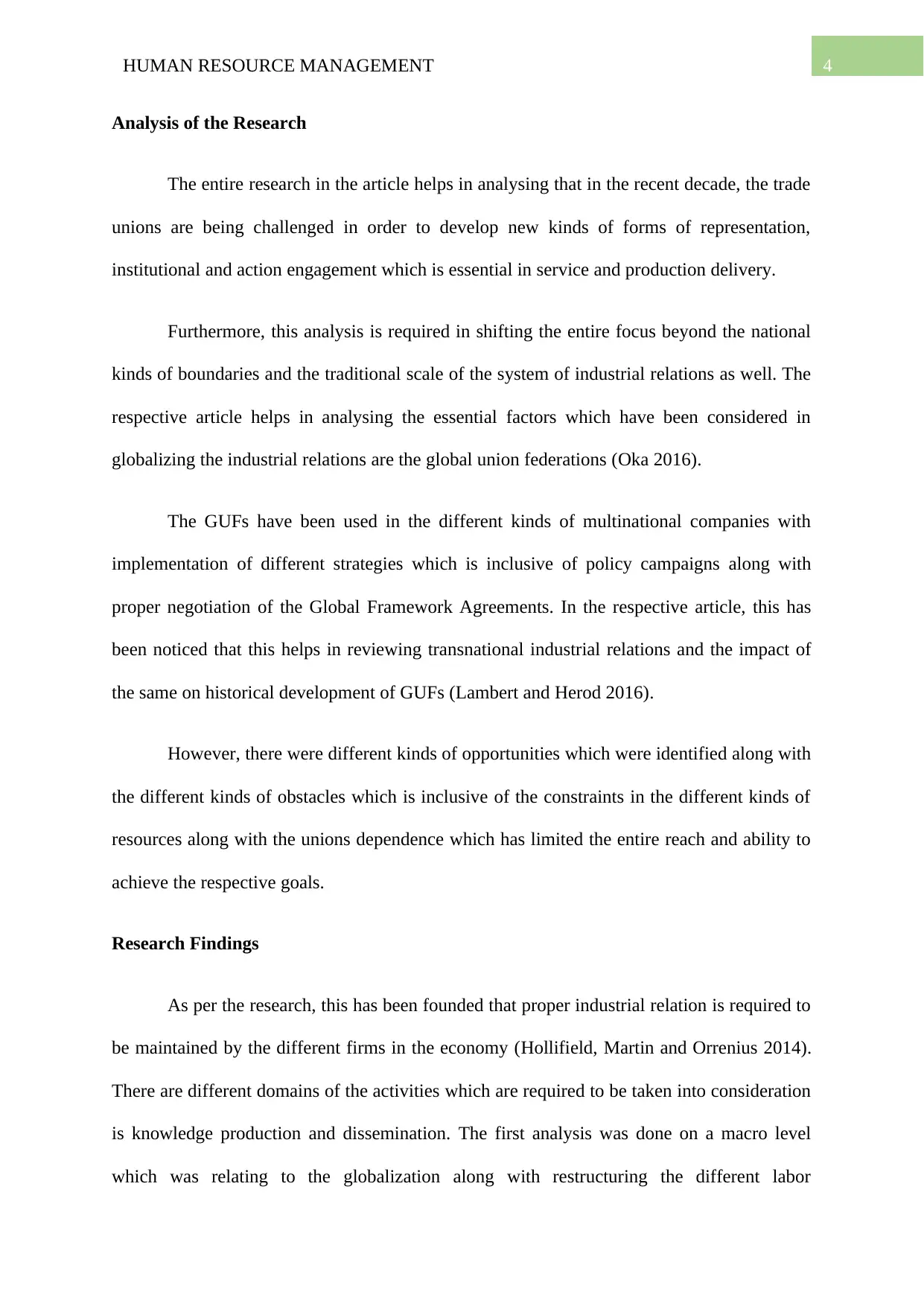
4HUMAN RESOURCE MANAGEMENT
Analysis of the Research
The entire research in the article helps in analysing that in the recent decade, the trade
unions are being challenged in order to develop new kinds of forms of representation,
institutional and action engagement which is essential in service and production delivery.
Furthermore, this analysis is required in shifting the entire focus beyond the national
kinds of boundaries and the traditional scale of the system of industrial relations as well. The
respective article helps in analysing the essential factors which have been considered in
globalizing the industrial relations are the global union federations (Oka 2016).
The GUFs have been used in the different kinds of multinational companies with
implementation of different strategies which is inclusive of policy campaigns along with
proper negotiation of the Global Framework Agreements. In the respective article, this has
been noticed that this helps in reviewing transnational industrial relations and the impact of
the same on historical development of GUFs (Lambert and Herod 2016).
However, there were different kinds of opportunities which were identified along with
the different kinds of obstacles which is inclusive of the constraints in the different kinds of
resources along with the unions dependence which has limited the entire reach and ability to
achieve the respective goals.
Research Findings
As per the research, this has been founded that proper industrial relation is required to
be maintained by the different firms in the economy (Hollifield, Martin and Orrenius 2014).
There are different domains of the activities which are required to be taken into consideration
is knowledge production and dissemination. The first analysis was done on a macro level
which was relating to the globalization along with restructuring the different labor
Analysis of the Research
The entire research in the article helps in analysing that in the recent decade, the trade
unions are being challenged in order to develop new kinds of forms of representation,
institutional and action engagement which is essential in service and production delivery.
Furthermore, this analysis is required in shifting the entire focus beyond the national
kinds of boundaries and the traditional scale of the system of industrial relations as well. The
respective article helps in analysing the essential factors which have been considered in
globalizing the industrial relations are the global union federations (Oka 2016).
The GUFs have been used in the different kinds of multinational companies with
implementation of different strategies which is inclusive of policy campaigns along with
proper negotiation of the Global Framework Agreements. In the respective article, this has
been noticed that this helps in reviewing transnational industrial relations and the impact of
the same on historical development of GUFs (Lambert and Herod 2016).
However, there were different kinds of opportunities which were identified along with
the different kinds of obstacles which is inclusive of the constraints in the different kinds of
resources along with the unions dependence which has limited the entire reach and ability to
achieve the respective goals.
Research Findings
As per the research, this has been founded that proper industrial relation is required to
be maintained by the different firms in the economy (Hollifield, Martin and Orrenius 2014).
There are different domains of the activities which are required to be taken into consideration
is knowledge production and dissemination. The first analysis was done on a macro level
which was relating to the globalization along with restructuring the different labor
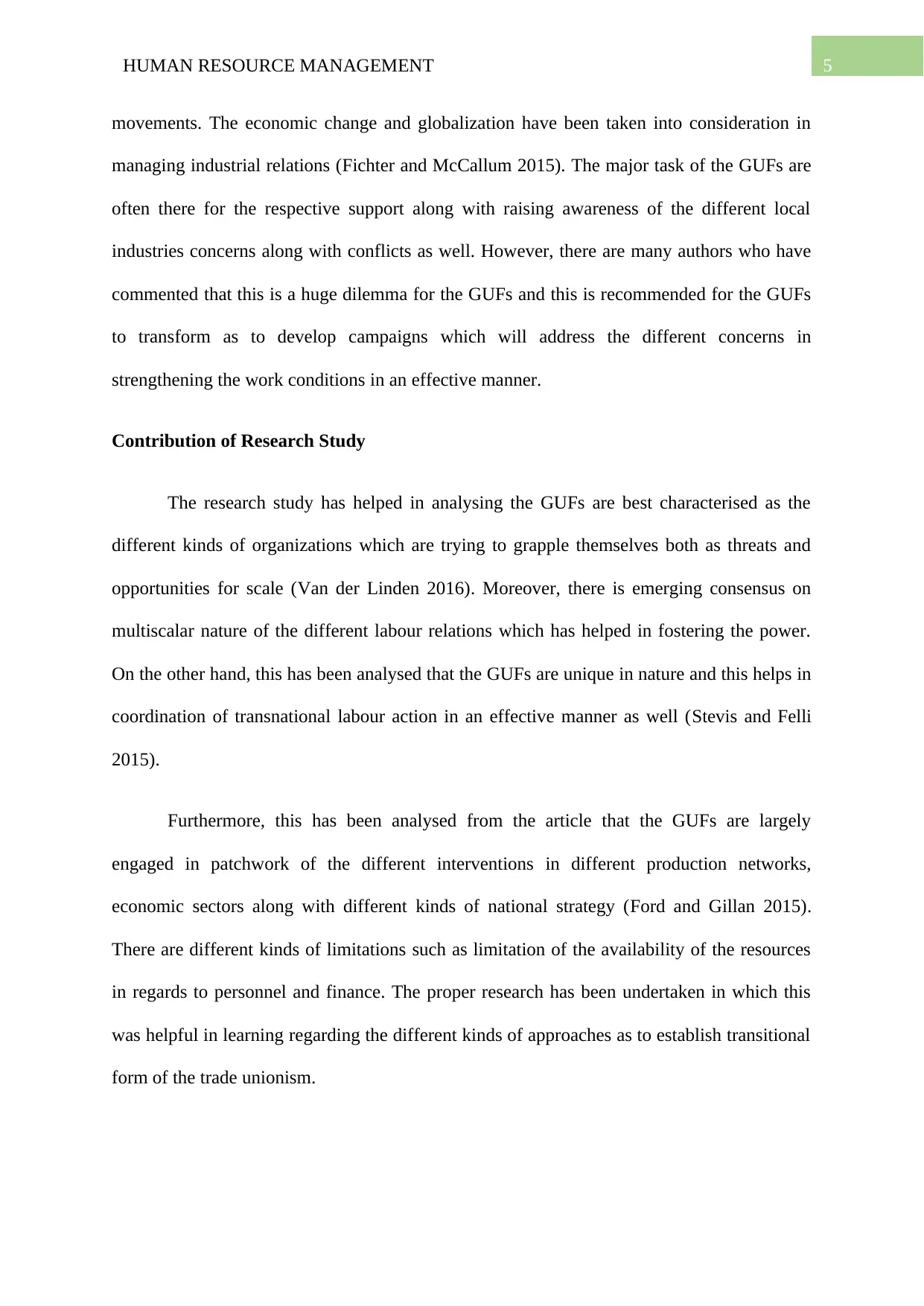
5HUMAN RESOURCE MANAGEMENT
movements. The economic change and globalization have been taken into consideration in
managing industrial relations (Fichter and McCallum 2015). The major task of the GUFs are
often there for the respective support along with raising awareness of the different local
industries concerns along with conflicts as well. However, there are many authors who have
commented that this is a huge dilemma for the GUFs and this is recommended for the GUFs
to transform as to develop campaigns which will address the different concerns in
strengthening the work conditions in an effective manner.
Contribution of Research Study
The research study has helped in analysing the GUFs are best characterised as the
different kinds of organizations which are trying to grapple themselves both as threats and
opportunities for scale (Van der Linden 2016). Moreover, there is emerging consensus on
multiscalar nature of the different labour relations which has helped in fostering the power.
On the other hand, this has been analysed that the GUFs are unique in nature and this helps in
coordination of transnational labour action in an effective manner as well (Stevis and Felli
2015).
Furthermore, this has been analysed from the article that the GUFs are largely
engaged in patchwork of the different interventions in different production networks,
economic sectors along with different kinds of national strategy (Ford and Gillan 2015).
There are different kinds of limitations such as limitation of the availability of the resources
in regards to personnel and finance. The proper research has been undertaken in which this
was helpful in learning regarding the different kinds of approaches as to establish transitional
form of the trade unionism.
movements. The economic change and globalization have been taken into consideration in
managing industrial relations (Fichter and McCallum 2015). The major task of the GUFs are
often there for the respective support along with raising awareness of the different local
industries concerns along with conflicts as well. However, there are many authors who have
commented that this is a huge dilemma for the GUFs and this is recommended for the GUFs
to transform as to develop campaigns which will address the different concerns in
strengthening the work conditions in an effective manner.
Contribution of Research Study
The research study has helped in analysing the GUFs are best characterised as the
different kinds of organizations which are trying to grapple themselves both as threats and
opportunities for scale (Van der Linden 2016). Moreover, there is emerging consensus on
multiscalar nature of the different labour relations which has helped in fostering the power.
On the other hand, this has been analysed that the GUFs are unique in nature and this helps in
coordination of transnational labour action in an effective manner as well (Stevis and Felli
2015).
Furthermore, this has been analysed from the article that the GUFs are largely
engaged in patchwork of the different interventions in different production networks,
economic sectors along with different kinds of national strategy (Ford and Gillan 2015).
There are different kinds of limitations such as limitation of the availability of the resources
in regards to personnel and finance. The proper research has been undertaken in which this
was helpful in learning regarding the different kinds of approaches as to establish transitional
form of the trade unionism.
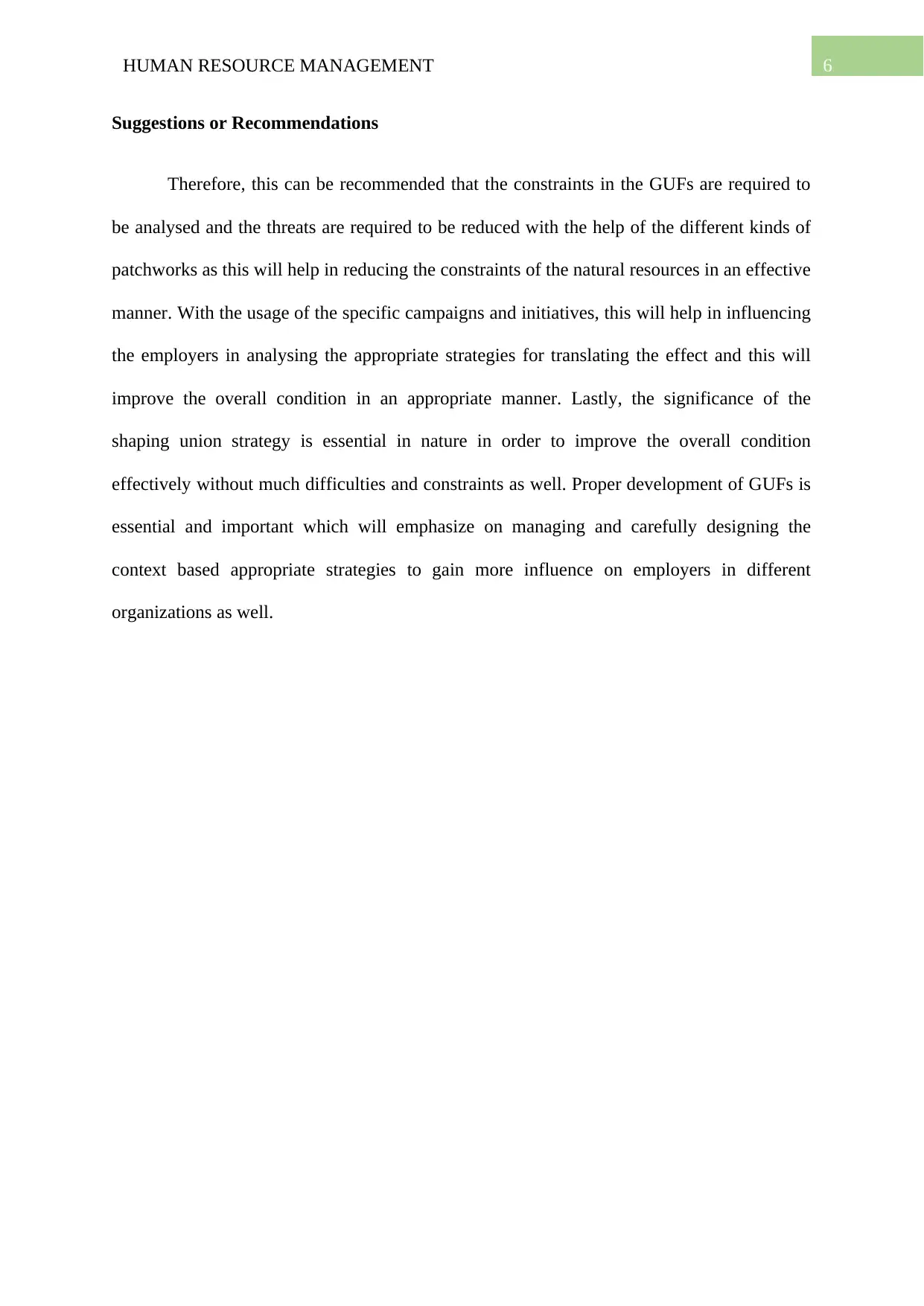
6HUMAN RESOURCE MANAGEMENT
Suggestions or Recommendations
Therefore, this can be recommended that the constraints in the GUFs are required to
be analysed and the threats are required to be reduced with the help of the different kinds of
patchworks as this will help in reducing the constraints of the natural resources in an effective
manner. With the usage of the specific campaigns and initiatives, this will help in influencing
the employers in analysing the appropriate strategies for translating the effect and this will
improve the overall condition in an appropriate manner. Lastly, the significance of the
shaping union strategy is essential in nature in order to improve the overall condition
effectively without much difficulties and constraints as well. Proper development of GUFs is
essential and important which will emphasize on managing and carefully designing the
context based appropriate strategies to gain more influence on employers in different
organizations as well.
Suggestions or Recommendations
Therefore, this can be recommended that the constraints in the GUFs are required to
be analysed and the threats are required to be reduced with the help of the different kinds of
patchworks as this will help in reducing the constraints of the natural resources in an effective
manner. With the usage of the specific campaigns and initiatives, this will help in influencing
the employers in analysing the appropriate strategies for translating the effect and this will
improve the overall condition in an appropriate manner. Lastly, the significance of the
shaping union strategy is essential in nature in order to improve the overall condition
effectively without much difficulties and constraints as well. Proper development of GUFs is
essential and important which will emphasize on managing and carefully designing the
context based appropriate strategies to gain more influence on employers in different
organizations as well.
Paraphrase This Document
Need a fresh take? Get an instant paraphrase of this document with our AI Paraphraser
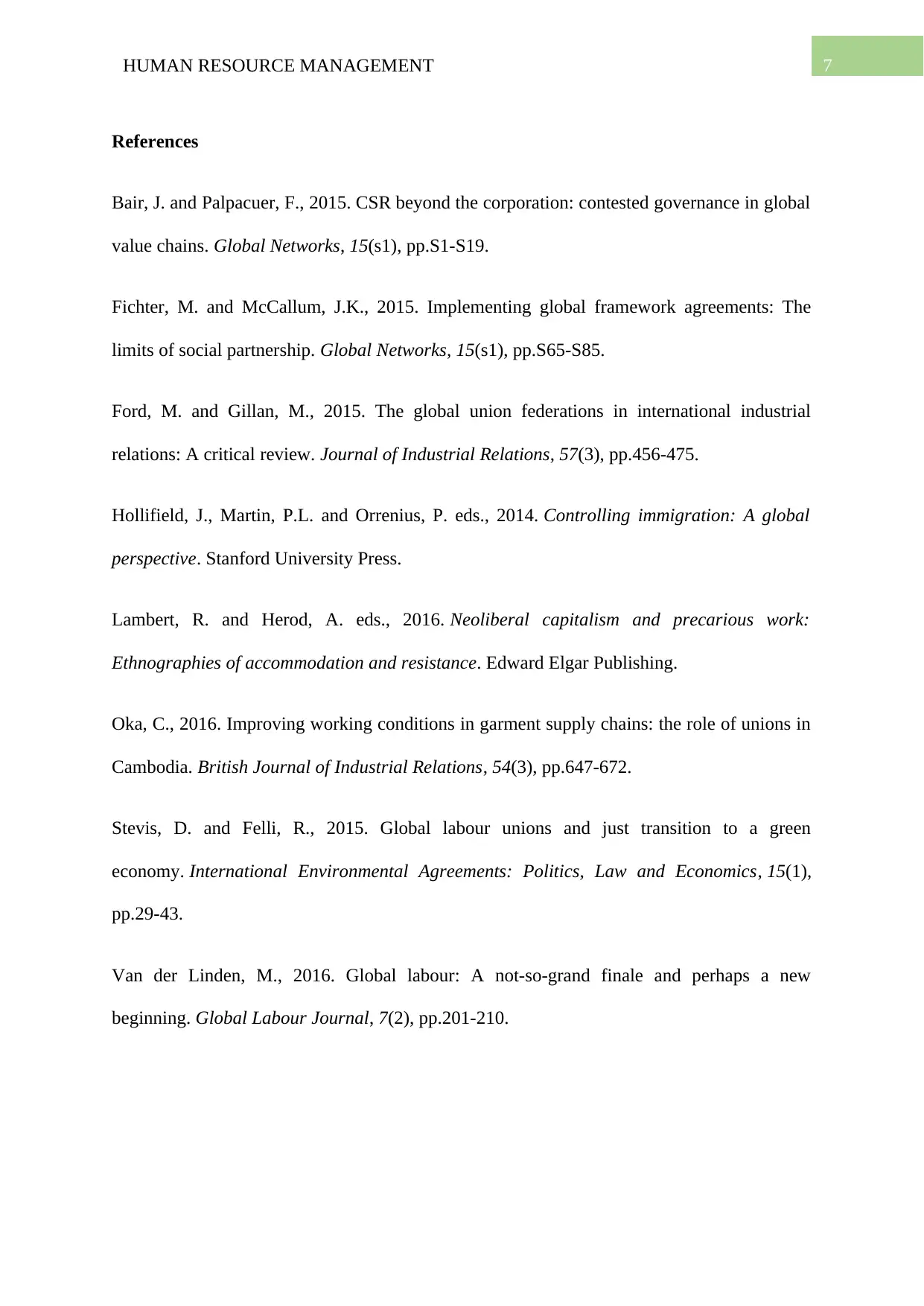
7HUMAN RESOURCE MANAGEMENT
References
Bair, J. and Palpacuer, F., 2015. CSR beyond the corporation: contested governance in global
value chains. Global Networks, 15(s1), pp.S1-S19.
Fichter, M. and McCallum, J.K., 2015. Implementing global framework agreements: The
limits of social partnership. Global Networks, 15(s1), pp.S65-S85.
Ford, M. and Gillan, M., 2015. The global union federations in international industrial
relations: A critical review. Journal of Industrial Relations, 57(3), pp.456-475.
Hollifield, J., Martin, P.L. and Orrenius, P. eds., 2014. Controlling immigration: A global
perspective. Stanford University Press.
Lambert, R. and Herod, A. eds., 2016. Neoliberal capitalism and precarious work:
Ethnographies of accommodation and resistance. Edward Elgar Publishing.
Oka, C., 2016. Improving working conditions in garment supply chains: the role of unions in
Cambodia. British Journal of Industrial Relations, 54(3), pp.647-672.
Stevis, D. and Felli, R., 2015. Global labour unions and just transition to a green
economy. International Environmental Agreements: Politics, Law and Economics, 15(1),
pp.29-43.
Van der Linden, M., 2016. Global labour: A not-so-grand finale and perhaps a new
beginning. Global Labour Journal, 7(2), pp.201-210.
References
Bair, J. and Palpacuer, F., 2015. CSR beyond the corporation: contested governance in global
value chains. Global Networks, 15(s1), pp.S1-S19.
Fichter, M. and McCallum, J.K., 2015. Implementing global framework agreements: The
limits of social partnership. Global Networks, 15(s1), pp.S65-S85.
Ford, M. and Gillan, M., 2015. The global union federations in international industrial
relations: A critical review. Journal of Industrial Relations, 57(3), pp.456-475.
Hollifield, J., Martin, P.L. and Orrenius, P. eds., 2014. Controlling immigration: A global
perspective. Stanford University Press.
Lambert, R. and Herod, A. eds., 2016. Neoliberal capitalism and precarious work:
Ethnographies of accommodation and resistance. Edward Elgar Publishing.
Oka, C., 2016. Improving working conditions in garment supply chains: the role of unions in
Cambodia. British Journal of Industrial Relations, 54(3), pp.647-672.
Stevis, D. and Felli, R., 2015. Global labour unions and just transition to a green
economy. International Environmental Agreements: Politics, Law and Economics, 15(1),
pp.29-43.
Van der Linden, M., 2016. Global labour: A not-so-grand finale and perhaps a new
beginning. Global Labour Journal, 7(2), pp.201-210.
1 out of 8
Related Documents
Your All-in-One AI-Powered Toolkit for Academic Success.
+13062052269
info@desklib.com
Available 24*7 on WhatsApp / Email
![[object Object]](/_next/static/media/star-bottom.7253800d.svg)
Unlock your academic potential
© 2024 | Zucol Services PVT LTD | All rights reserved.




